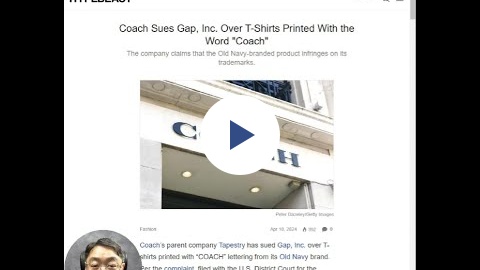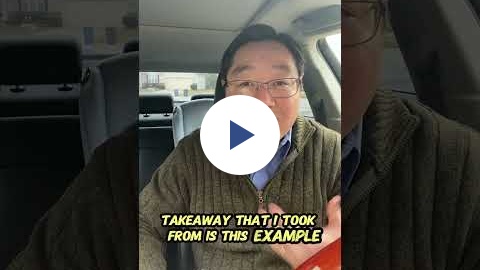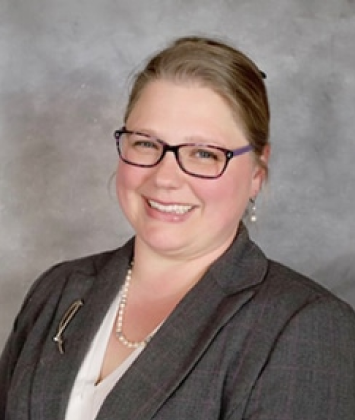Coach Sues Gap, Inc. Over T-Shirts Printed with the Word "Coach"
Hello Reader,
Coach Sues Gap, Inc. Over T-Shirts Printed with the Word "Coach"
Coach’s parent company Tapestry has sued Gap, Inc. over T-shirts printed with “COACH” lettering from its Old Navy brand. 
Transcript:
Hi, JJ Trademark Attorney here. We're doing another litigation series and this time it's Coach Suing Gap over t-shirts printed with the word "coach" on them. You know the Coach brand. You see it right here. We're going to look at their filing. They filed it in the Central District of California. It's an interesting case because I kind of can imagine, and this is all speculation, I don't know, it's all speculation, but Coach of course is a brand, a well-known brand.
However, in a situation like this, when they're asking Old Navy, which is owned by GAP, to cease and desist the word "coach," and I'll show you pictures of it, where is the line in terms of what that means? And so, I'm going to show you pictures with it. Does that prevent somebody from putting the word coach?
If they're a basketball coach, a football coach on a hat or, or on a shirt. This was just filed April 2nd, 2024. And of course, when you go through the complaint, I'll put it, I'll put the link in the notes below. Coach comes out and stating, these are our brands, these are our registered trademarks for coach, coach, coach.
This is for, of course these are designed with fonts, stylized fonts, or this one with a design as well. This is standard character mark, which means they own the word coach, under clothing. Here in this case, they also list the infringement, the counterfeit. This is the Old Navy's version of it.
Coach here. Coach here. What they clearly show is the brand, the hang tag, with Old Navy on there as well. So, again, speculation. I can see Coach saying cease and desist. Old Navy saying this is just merely ornamental. It just lets maybe a sports coach. That's kind of the implication on there. It's not meant to have any infringement.
I don't know. Really quick question, would you think, if you saw this, it, the source identifier is for the coach handbags? Question there. So, we, I'll, I'll be monitoring this, I'll be following along with this, but I was just curious, kind of back and forth. From my perspective, it's a little risky for a coach.
Um, I'd be surprised if they don't settle it. The reason is, I don't know. If coach wins, there's going to be a big uproar of everybody saying, well, can we not put the word coach, you know, coach JJ or whatever on our shirts. Is that going to be problematic if they lose, then they lose all of that. So there's, there's a higher risk for coach.
To lose in this, in this situation here, then for Old Navy to just kind of give it up. Sadly, I think it's going to get to settlement and we're not going to see the results of any of it. All right. Until next time, keep your brand safe and protected.
TRADEMARK NEWS
Coach’s parent company Tapestry has sued Gap, Inc. over T-shirts printed with “COACH” lettering from its Old Navy brand. Coach Sues Gap, Inc. Over T-Shirts Printed with the Word "Coach" TRADEMARK Litigation Documents
Tapestry, Inc., Coach IP Holdings, LLC and Coach Services, Inc. US District Court Central District of California BUSINESS TIPS AND TRICKS
This is Week 11 and Chapter 11 of our 20-part Atomic Habits by James Clear weekly read through! Get the book and join us every week!

Transcript:
Hello! Welcome to week 11. Chapter 11. We're in a new section.
The third law: "Make It Easy"
This chapter 11 is called "Walk Slowly but Never Backwards." James Clear mentions a professor, Jerry Uelsmann, from the University of Florida, who did an experiment. He divided his film photography class into two groups. One group was the quantity group.
The other group was the quality group. And the task was for the quantity group to take as many photos as possible. The quality group only had one picture needed to submit, but it needed to be perfect. What they found was the best photos came from the quantity group. The reason was over the hundreds of pictures that they've taken, they've honed their skills.
They learned from their mistakes, and they tried different variations. This is what it needs to create a habit and to come to perfection. He mentions a huge difference between motion and action. For example, motion for getting in shape is calling fitness. You're going through the motion of talking to people about how to exercise.
You're setting up a plan, but you're not taking any action. The action is actually doing the exercise. We think that we're doing something, but we're not doing anything. We're just preparing to do something. And there's a huge difference between actually going through the motions and taking action. It's the actions that count and the more actions you take, the more repetitions you take.
The easier that it becomes a habit. Another question that he's typically asked is: "How long does it take for a habit to form?" And he counters it by saying, "It's not how long, but how many times." Quantity, the repetition, the amount of time you do it, matters more than the length of time. If you want to build a habit quickly, then do the repetitions more often.
The more frequently you can do the repetitions, the more it becomes a habit. All right, that's chapter 11. We'll see you next week for week 12, chapter 12.
If you would like to follow along with the series, here is our Atomic Habits by James Clear playlist:

Thank you for being a part of our community, and we look forward to helping you safeguard your brand's identity and thrive in the world of trademarks!
Warm regards,
J.J. Lee and the Trademark Lawyer Law Firm Team! PS. Be Sure to Add Us to Your Contacts 📞 To ensure that you never miss an important update or exclusive offer from us, please add our email address to your contacts. This way, you can rest assured that our newsletters will always land safely in your inbox, ready to be explored.







